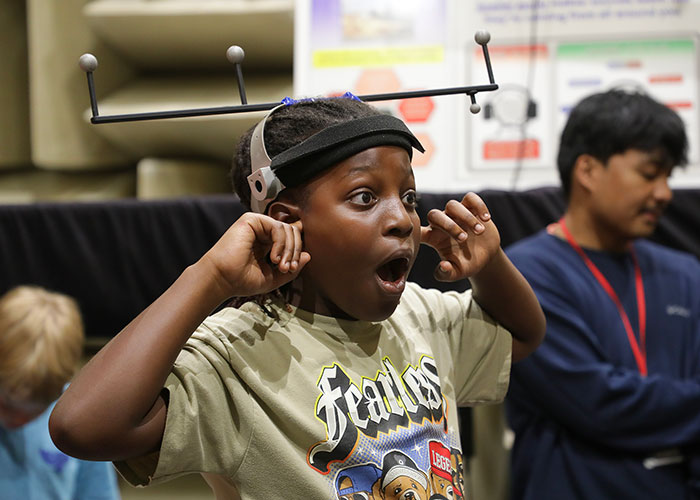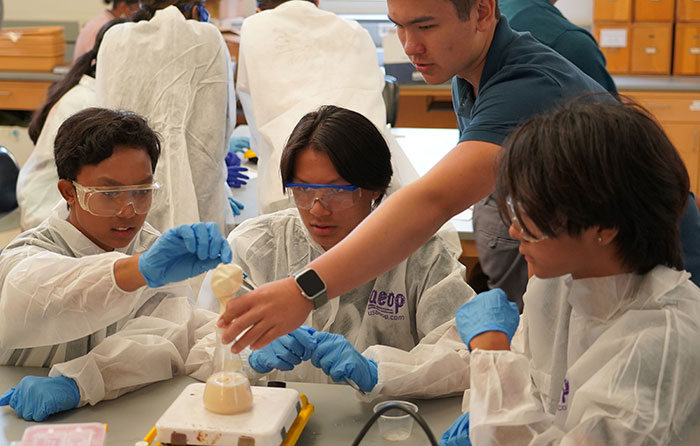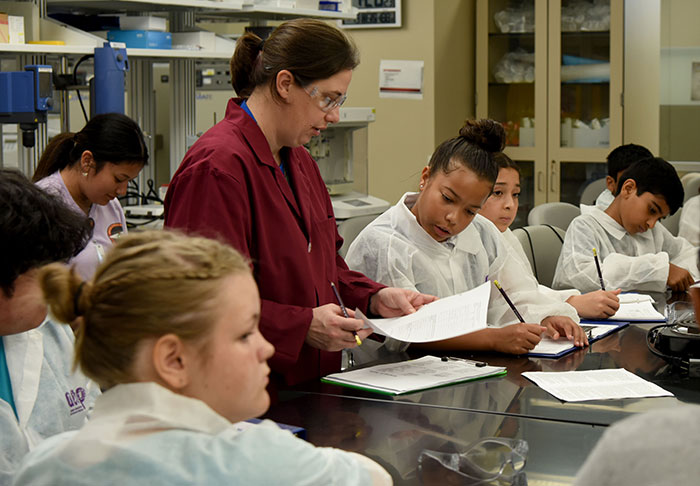GEMS Program Sparks Innovative Thinking in Students

FORT DETRICK, Md. – Over 2,100 students participated in this year's Gains in the Education of Mathematics and Science summer programs at six U.S. Army Medical Research and Development Command research laboratories around the country, engaging in creative hands-on experiments and activities that tested their problem-solving skills alongside career researchers from across Army medicine.
From June through August, elementary, middle and high school students attended one-week classes focused on particular STEM fields like robotics, biochemistry, agronomy, computer science, forensics, environmental science and chemistry. In addition to the Fort Detrick program, which is held at nearby Hood College, GEMS classes also took place at U.S. Army Aeromedical Research Laboratory at Fort Novosel, Alabama; the U.S. Army Institute of Surgical Research at Joint Base San Antonio, Texas; the U.S. Army Medical Research Institute of Chemical Defense at Aberdeen Proving Ground, Maryland; the U.S. Army Research Institute of Environmental Medicine in Natick, Massachusetts; and the Walter Reed Army Institute of Research in Silver Spring, Maryland.
MRDC has participated in the GEMS program for over 30 years, beginning with WRAIR in the early 1990s, followed by MRDC at Fort Detrick in 2005 and the other four participating laboratories in 2011 and 2012. Erica Innis, the coordinator of this year's Fort Detrick program, says the program's positive reputation has made it easy to find people to teach the students, serve as near-peer mentors and speak to them about STEM career opportunities.
"When people found out I was going to be coordinating the GEMS program this year, they would get excited and say, 'Oh, I love the GEMS program!'" says Innis. "Everybody knows about it and supports it. It's a great opportunity for people throughout the command to share their knowledge and experience with students who may have never met a scientist or an engineer before."

Lt. Col. Bridget Owens, the GEMS program coordinator at USARIEM, agrees.
"GEMS is an invaluable program that provides local students with exposure to Army leaders, researchers and engineers working in STEM careers with the DOD," says Owens.
Reaching youth from underserved and underrepresented communities is a core principle of the GEMS program, and it is one at which MRDC ''s labs have traditionally excelled. This year, at WRAIR and USAISR approximately three-quarters of the participating students were from underserved and underrepresented communities; at USAARL, that figure reached nearly 80% -- placing all three programs among the top rankings of GEMS programs nationally in that important category. GEMS classes also bring together students from broad geographic areas, allowing them to interact with people they might not otherwise meet. The 729 students who participated in WRAIR's program this summer, for example, represented just over 300 middle and high schools from across Maryland and surrounding states.
"GEMS is the beginning of a wonderful continuum of STEM programs administered by the Army Educational Outreach Program that can guide our young people stepwise toward a science or engineering career," says Dr. Debra Yourick, WRAIR's director of science education and fellowship programs, who co-founded MRDC's first GEMS program.
In addition to GEMS, AEOP administers the Camp Invention summer program for K-6 students, the Junior Solar Sprint solar-powered car competition, the virtual eCYBERMISSION challenge, an annual Junior Science and Humanities Symposium program that encourages students in grades 9-12 to submit original research to be judged regionally and nationally and the summer UNITE program that takes place on college campuses. AEOP also offers paid internships and fellowships.
For many students, participating in the GEMS program changes their perspectives about the Army in positive ways.

"I learned about the jobs you can do in the military, and I now have a bigger respect for those who serve in the Army," wrote one student last year. Another student wrote, "It broadened my mind for possible careers in the Army and the different pathways I can take throughout my student career."
Innis says that this is exposure to the wide range of career paths in the military, and at MRDC in particular, is intentional.
"We try to select staff who have careers that the students might not think of as things you can do in the military," says Innis. "This year we had people talk to the students about what it's like being a lawyer, being a safety officer, even about being a veterinarian. And afterwards, students would come up to me and ask me for the speakers' contact information. One student was able to arrange an internship for a position that he thought you had to join the military to do."
Innis says that at this year's classes at Hood College, subject matter experts spent a morning or an afternoon helping students learn lab skills such as wound suturing and animal dissection, forensic analysis techniques like blood typing and fingerprint analysis, and even effective public speaking and presentation skills. At USAISR, a subject matter expert instructed students in how to render aid to an injured person who is bleeding, for which they earned certificates from the American College of Surgeons' "Stop the Bleed" campaign – a program that MRDC's Combat Casualty Care Research Program helped develop.
"The students always want more after their week is over," says Innis. "They tell me that they wish they could come back or that it lasted two weeks instead of just one. When parents pick up their kids at the end of the day, many of them tell me how excited and engaged their kids are. Participating in GEMS is very rewarding for everyone involved – for the organizers like me, for the teachers, mentors and guest speakers, but especially for the students. And that's a good thing."














